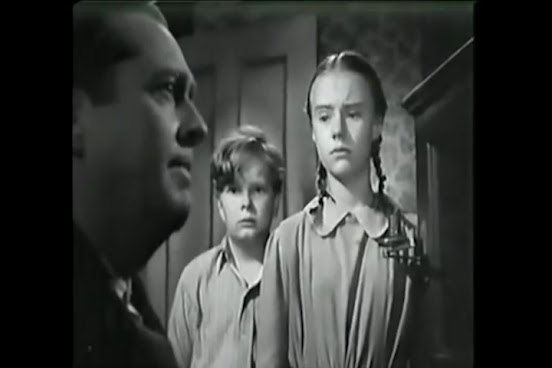Film Studies Quarterly Review: A Scene Study on "A Tree Grows in Brooklyn" with Bolivar T. Caceres
*Super Spoiler*
In conjunction with Film Studies Quarterly’s Essay #7: Adapting to Life’s Hand - A Study of “A Tree Grows in Brooklyn" (1945),” Bolivar analyzes one scene and how it fits within the the large theme of adaptation. The scene stars James Dunn, Dorothy McGuire, Peggy Ann Garner, and Ted Donaldson. It’s a poignant scene layered with despair and optimism.
Check out the scene and lets dive into Elia Kazan’s first film “A Tree Grows In Brooklyn." Leave a comment below and tell us your thoughts of today’s scene.
Johnny Nolan arrives home after a night of work and drinking away his sorrows, but it's not his home. That is to say, it's not the same apartment where he left his family the night before. The Nolans have moved upstairs to a smaller apartment with no bathroom to save money. A baby's on the way, and Johnny's job isn't consistent.
During his initial shock, expressed merely in his silence, his family tries to buck him up and have him see the brighter side: they have access to the roof and a view of "the tree." But within this byplay, the viewer will experience the tugging struggle to adapt.
Can the Nolans overcome their predicament and come back on top? Can this new apartment on the top floor be seen figuratively as an upward step in the right direction?
Elia Kazan does not answer these questions, as, throughout the entire film, the characters are too preoccupied with their emotions kindled by their predicament. In this scene, optimism and despair battle it out.
Although Johnny's children attempt to revigorate his positive attitude, despair gives him no chance for it to grow. "Does pop know?" Asked Nelly, referring to a young girl that died next door. Johnny doesn't know anything but that he's stony broke.
"Only now the poor things have to wear them lying in potter's field," Katie bites back at Johnny's optimism: "at least her mother got her all those dresses." Despair has already conquered Katie; to her, no matter what she does, she is bound to lose. Therefore her children have to take the risk.
The animosity between husband and wife is palpable. The viewer will wonder if they hate each other. They don't, but frequently, one's ordeal can be the flame to a pressure burner, causing emotions and words to fly unwarrantedly.
Ignoring Johnny's attempt at returning to his positive attitude, repeating, "at least her mother got her all those dresses," Katie tells the children to show her father the piano. The piano belonged to the previous tenant.
At this moment in the scene, optimism seems to have won. Music, Johnny's love, is to bring happiness and life to the Nolan family. With a piano, Johnny can offer lessons, bring in a little cash, and maybe things would be on the up and up.
Johnny thinks, "Now that we have a piano, I can finally teach you, kids, how to play." But, Nolan's poverty and continuous losses have made their minds a breeding ground for despair. Johnny shakes the idea off as foolish and not worth the effort.
So, he sits down to play and sing, "Annie Laurie."
Johnny crones from his heart, letting out his despair — well, trying to anyway. Francie and Nelly stand by their father, listening to the song and admiring their father's ability. One can imagine they seldom see or hear their father perform. In the background, Katie unpacks and arranges their new apartment; she wants to take no notice of the song and her husband, but who can? It's a beautiful rendition that deserves repeat plays.
"I never heard you play that before," she says, finally coming around. So far, despair has been losing the battle against optimism. The song brings the family together, helping them heal and forget.
However, although the song is beautiful, fills the room with sound, and engenders positivity, there is the elephant in the room, the silence, animosity, and hopelessness felt in the opening minutes of this scene. The song cannot quell this silence; thus, it can't quell despair.
Johnny doesn't react to his wife's invitation towards unity, peace (even if specious,) and optimism. He merely continues to play. With the aid of Johnny, despair has superman punched optimism for the count. And this abrupt disregard for his wife is the visual representation of this unspoken battle.
This scene, fraught with the struggle to adapt and remain optimistic, does so not by the music or the battle between optimism and despair but by using the Hays Code restraints to its advantage. So, next time you watch this scene, pay attention to what is not said.
To learn more about Elia Kazan’s “A Tree Grows in Brooklyn,” read Essay #7: Adapting to Life’s Hand.
You can also watch a few scene clips on Film Studies Quarterly Review’s Youtube, where you can also find more on “A Tree Grows in Brooklyn.” .
Interested in the soundtrack for “A Tree Grows In Brooklyn”? Check out our collection.
And while you're at it, listen to Film Studies Quarterly Reviews's First Take and Top 5 with Bolivar T. Caceres to hear our first impressions and analyses.
Leave a comment below and tell us your thoughts of today’s scene featured in Elia Kazan’s “A Tree Grows In Brooklyn.”
Bolivar T. Caceres is a Bronx-based artist and writer. His poems appear on ShortEdition and Ariel Chart. He is also the author of the chapbook Outside My Garret Window, published in 2020. He currently writes for the quarterly film blog Film Studies 401 and the news blog New York Positivity. Connect with him on social media @BolivarTCaceres and at www.BtcArt.co.








Comments
Post a Comment